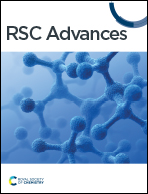Polyvinyl alcohol/propylene glycol facilitates reversible thermochromism of passive energy-saving flexible wood films at low (brightness) to high (depth) temperatures†
Abstract
Reversible thermochromism presents depth at low temperatures and brightness at high temperatures, which is not conducive to the application of the passive energy-saving and shading effect. Here, we propose an innovative strategy for unconventional reversible thermochromic energy-storage flexible wood films (FT-PCMs-2) by the contribution of polyvinyl alcohol/propylene glycol (PVA/PG). Upon heating, the FT-PCMs-2 changes from light red/green to dark red/green, in contrast to the color change of the non-flexible composites without PVA/PG. The FT-PCMs-2 has good flexibility, mechanical strength and thermal stability. Among them, MSR-DEW-6PVA and MSG-DEW-6PVA have better comprehensive properties, including suitable phase change temperatures (38.6 °C and 37.2 °C), high latent heat values (59.79 J g−1 and 73.02 J g−1), and low supercooling degrees (2 °C and 0.6 °C). FTIR, XRD and SEM analysis show that the binary fatty acid eutectics were successfully loaded into the eucalyptus fibre skeleton with physical interaction with PVA/PG. In addition, MSR-DEW-6PVA and MSG-DEW-6PVA have photothermal conversion rates of 48.3% and 36%, good cycling stability and anti-leakage performance after 50 cycles, and have promising applications in the fields of building energy saving, intelligent windows and decoration.



 Please wait while we load your content...
Please wait while we load your content...